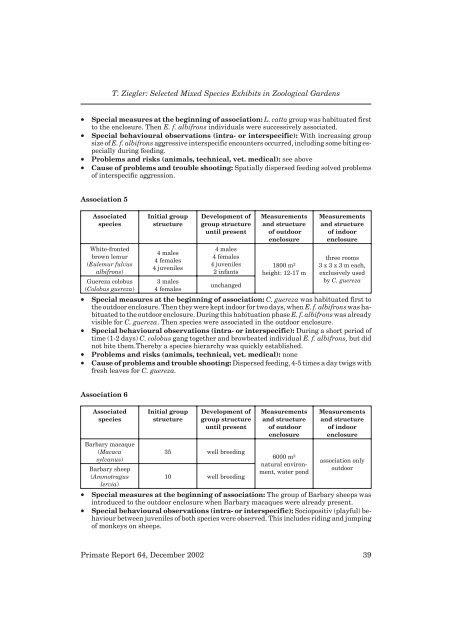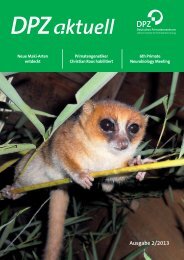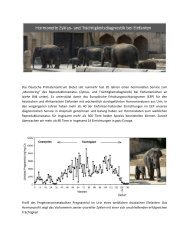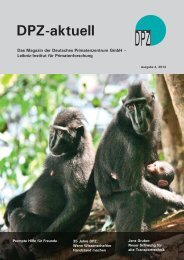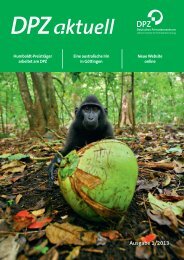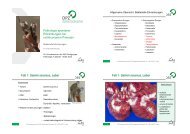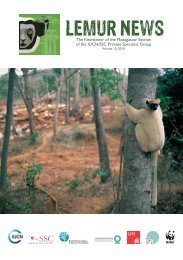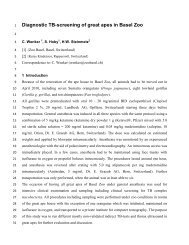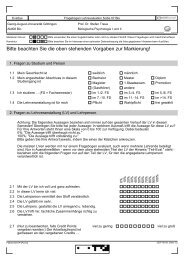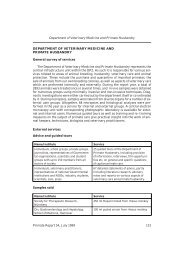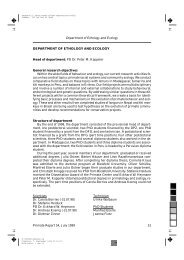Selected Mixed Species Exhibits of Primates in German ... - DPZ
Selected Mixed Species Exhibits of Primates in German ... - DPZ
Selected Mixed Species Exhibits of Primates in German ... - DPZ
You also want an ePaper? Increase the reach of your titles
YUMPU automatically turns print PDFs into web optimized ePapers that Google loves.
• Special measures at the beg<strong>in</strong>n<strong>in</strong>g <strong>of</strong> association: L. catta group was habituated first<br />
to the enclosure. Then E. f. albifrons <strong>in</strong>dividuals were successively associated.<br />
• Special behavioural observations (<strong>in</strong>tra- or <strong>in</strong>terspecific): With <strong>in</strong>creas<strong>in</strong>g group<br />
size <strong>of</strong> E. f. albifrons aggressive <strong>in</strong>terspecific encounters occurred, <strong>in</strong>clud<strong>in</strong>g some bit<strong>in</strong>g especially<br />
dur<strong>in</strong>g feed<strong>in</strong>g.<br />
• Problems and risks (animals, technical, vet. medical): see above<br />
• Cause <strong>of</strong> problems and trouble shoot<strong>in</strong>g: Spatially dispersed feed<strong>in</strong>g solved problems<br />
<strong>of</strong> <strong>in</strong>terspecific aggression.<br />
Association 5<br />
Associated<br />
species<br />
White-fronted<br />
brown lemur<br />
(Eulemur fulvus<br />
albifrons)<br />
Guereza colobus<br />
(Colobus guereza)<br />
Initial group<br />
structure<br />
4 males<br />
4 females<br />
4 juveniles<br />
3 males<br />
4 females<br />
Development <strong>of</strong><br />
group structure<br />
until present<br />
4 males<br />
4 females<br />
4 juveniles<br />
2 <strong>in</strong>fants<br />
unchanged<br />
Measurements<br />
and structure<br />
<strong>of</strong> outdoor<br />
enclosure<br />
1800 m 2<br />
height: 12-17 m<br />
Measurements<br />
and structure<br />
<strong>of</strong> <strong>in</strong>door<br />
enclosure<br />
three rooms<br />
3x3x3meach,<br />
exclusively used<br />
by C. guereza<br />
• Special measures at the beg<strong>in</strong>n<strong>in</strong>g <strong>of</strong> association: C. guereza was habituated first to<br />
the outdoor enclosure. Then they were kept <strong>in</strong>door for two days, when E. f. albifrons was habituated<br />
to the outdoor enclosure. Dur<strong>in</strong>g this habituation phase E. f. albifrons was already<br />
visible for C. guereza. Then species were associated <strong>in</strong> the outdoor enclosure.<br />
• Special behavioural observations (<strong>in</strong>tra- or <strong>in</strong>terspecific): Dur<strong>in</strong>g a short period <strong>of</strong><br />
time (1-2 days) C. colobus gang together and browbeated <strong>in</strong>dividual E. f. albifrons, but did<br />
not bite them.Thereby a species hierarchy was quickly established.<br />
• Problems and risks (animals, technical, vet. medical): none<br />
• Cause <strong>of</strong> problems and trouble shoot<strong>in</strong>g: Dispersed feed<strong>in</strong>g, 4-5 times a day twigs with<br />
fresh leaves for C. guereza.<br />
Association 6<br />
Associated<br />
species<br />
Barbary macaque<br />
(Macaca<br />
sylvanus)<br />
Barbary sheep<br />
(Ammotragus<br />
lervia)<br />
T. Ziegler: <strong>Selected</strong> <strong>Mixed</strong> <strong>Species</strong> <strong>Exhibits</strong> <strong>in</strong> Zoological Gardens<br />
Initial group<br />
structure<br />
Development <strong>of</strong><br />
group structure<br />
until present<br />
35 well breed<strong>in</strong>g<br />
10 well breed<strong>in</strong>g<br />
Measurements<br />
and structure<br />
<strong>of</strong> outdoor<br />
enclosure<br />
6000 m 2<br />
natural environment,<br />
water pond<br />
Measurements<br />
and structure<br />
<strong>of</strong> <strong>in</strong>door<br />
enclosure<br />
association only<br />
outdoor<br />
• Special measures at the beg<strong>in</strong>n<strong>in</strong>g <strong>of</strong> association: The group <strong>of</strong> Barbary sheeps was<br />
<strong>in</strong>troduced to the outdoor enclosure when Barbary macaques were already present.<br />
• Special behavioural observations (<strong>in</strong>tra- or <strong>in</strong>terspecific): Sociopositiv (playful) behaviour<br />
between juveniles <strong>of</strong> both species were observed. This <strong>in</strong>cludes rid<strong>in</strong>g and jump<strong>in</strong>g<br />
<strong>of</strong> monkeys on sheeps.<br />
Primate Report 64, December 2002 39


